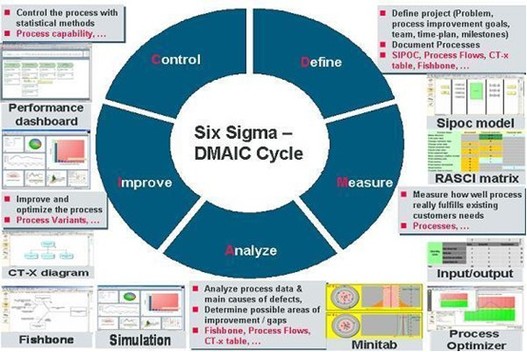|
Six SigmaWhat is Six Sigma?
Six sigma is the structured application of statistical tools and techniques applied on project basis to achieve sustained strategic results. DMAIC six sigma approach The six sigma approach for projects is DMAIC (define, measure, analyze, improve and control). These steps are the most common six sigma approach to project work. Some organizations omit the D in DMAIC because it is really management work. With the D dropped from DMAIC the Black Belt is charged with MAIC only in that six sigma approach. We believe define is too important be left out and sometimes management does not do an adequate job of defining a project. Our six sigma approach is the full DMAIC. Define (DMAIC) Define is the first step in our six sigma approach of DMAIC. DMAIC first asks leaders to define our core processes. It is important to define the selected project scope, expectations, resources and timelines. The definition step in the six sigma approach identifies specifically what is part of the project and what is not, and explains the scope of the project. Many times the first passes at process documentation are at a general level. Additional work is often r equired to adequately understand and correctly document the processes. Measure (DMAIC) Many think when they start a journey the most important thing to know is where they are going. While we agree knowing where you want to go is very important, we believe some of the first information you need before starting any journey is your current location. The six sigma approach asks the Black Belt project manager to quantify and benchmark the process using actual data. At a minimum consider the mean or average performance and some estimate of the dispersion or variation (maybe even calculate the standard deviation). Trends and cycles can also be very revealing. The two data points and extrapolate to infinity is not a six sigma approach. Process capabilities can be calculated once there is performance data. Analyze (DMAIC) Once the project is understood and the baseline performance documented and verified that there is real opportunity, it is time with the six sigma approach to do an analysis of the process. In this step, the six sigma approach applies statistical tools to validate root causes of problems. Any number of tools and tests can be used. The objective is to understand the process at a level sufficient to be able to formulate options for improvement. We should be able to compare the various options with each other to determine the most promising alternatives. As with many activities, balance must be achieved. Superficial analysis and understanding will lead to unproductive options being selected, forcing recycle through the process to make improvements. At the other extreme is the paralysis of analysis. Striking the appropriate balance is what makes the six sigma Black Belt highly valuable. Improve (DMAIC) During the improve step of the six sigma approach ideas and solutions are put to work. The six sigma Black Belt has discovered and validated all known root causes for the existing opportunity. The six sigma approach requires Black Belts to identify solutions. Few ideas or opportunities are so good that all are an instant success. As part of the six sigma approach there must be checks to assure that the desired results are being achieved. Some experiments and trials may be required in order to find the best solution. When making trials and experiments it is important that all project associates understand that these are trials and really are part of the six sigma approach. Control (DMAIC) Many people believe the best performance you can ever get from a process is at the very beginning. Over time there is expectancy that slowly things will get a little worse until finally it is time for another major effort towards improvement. Contrasted with this is the Kaizen approach that seeks to make everything incrementally better on a continuous basis. The sum of all these incremental improvements can be quite large. As part of the six sigma approach performance tracking mechanisms and measurements are in place to assure, at a minimum, that the gains made in the project are not lost over a period of time. As part of the control step we encourage sharing with others in the organization. With this the six sigma approach really starts to create phenomenal returns, ideas and projects in one part of the organization are translated in a very rapid fashion to implementation in another part of the organization. Benefits of Six Sigma There are numerous benefits of six sigma as a way to address issues and problems. Among the benefits of six sigma is the decrease in defects that are allowed to reach the customer. You can get some sense of the benefits of six sigma by reviewing some six sigma projects. Other benefits of six sigma include: · Focus on customers. · Improved customer loyalty. · Reduced cycle time. · Less waste. · Data based decisions. · Time management. · Sustained gains and improvements. · Systematic problem solving. · Employee motivation. · Data analysis before decision making. · Faster to market. · Team building. · Improved customer relations. · Assure strategic planning. · Reductions of incidents. · Measure value according to the customer. · Better safety performance. · Understanding of processes. · Effective supply chain management. · Design and redesign products/services. · Knowledge of competition, competitors. · Develop leadership skills. · Breakdown barriers between departments and functions. · Management training. · Improve presentation skills. · Integration of products, services and distribution. · Use of standard operating procedures. · Better decision making. · Improving project management skills. · Sustained improvements. · Alignment with strategy vision, and values. · Increased margins. · Greater market share. · Supervisor training. · Lower costs to provide goods and services. . Fewer customer complainta |


